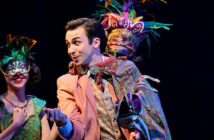Tchaikovsky: Romeo and Juliet
Bernstein: Serenade for Violin Solo, Strings, Harp and Percussion
Wagner: Tristan und Isolde: Prelude and Liebestod
No doubt, we live in trying times. Like the rest of us, symphony orchestras are trying to cope as best they can. Some have found ingenious solutions, others are just bumbling along, still others have decided they will simply wait it out. The Montreal Symphony Orchestra is among those who have opted for alternative solutions. If concerts cannot be presented in the usual way, that is, in concert halls with audiences, they will offer music-making on the web – and at the highest possible level.
The MSO is partway through a series of concerts available via webcast from January to March 2021. Three have been given already with music director designate Rafael Payare on the podium. On Feb. 9 the music director of the National Arts Centre Orchestra, Alexander Shelley, paid a virtual visit – although the concert was in fact recorded on Nov. 19.
The MSO faces stiff overseas competition as a purveyor of online content. By any standard the Berlin Philharmonic is among the world’s finest orchestras and it has also been a leader in making its concerts available through audio recordings, DVDs and webcasts. Its Digital Concert Hall (www.digitalconcerthall.com) has been going for years now and is state of the art as far as audio and video techniques are concerned. The BPO has also set the standard for webcasts through the pandemic. New BPO concerts are presented almost every week.
While the first BPO pandemic concerts featured only a handful of musicians, widely distanced and wearing masks, the full orchestra now appears much as it always has, and with nary a mask to be seen. So far, no reports of COVID-19 outbreaks either. Not to be outdone, the Vienna Philharmonic toured Japan recently using its usual concert set-up – no masks, no social distancing – and again no reports of outbreaks. And just last week Daniel Barenboim and the Vienna Philharmonic gave a concert in Salzburg as part of Mozart Week in the same fashion.
For the record, both Germany and Austria have imposed pretty strict regulations to deal with COVID-19 and those regulations have prohibited public concerts. But nonetheless the Berlin Philharmonic and the Vienna Philharmonic have been able to continue making music, and to make it without masks or social distancing, and, most importantly, apparently without risking the safety of their musicians.
Meanwhile, pretty much across Canada orchestras have ceased to give symphony concerts, with or without audiences. The MSO, to its credit, has found a way. But why do they feel the need to enforce social distancing, and require masks for nearly all the musicians? Is Montreal a riskier place to play than Berlin or Vienna? Are the authorities more demanding? Does it matter? Speaking for myself, I do feel that something important is lost when musicians cannot sit near each other when they play, and when they cannot see the conductor’s face.
Let me be clear, however, that I sympathize with musicians, conductors and orchestra managers who must try to navigate their way through a pandemic that is life-threatening, business-killing and soul-destroying. Many of them are working wonders under impossible conditions. And last night what I saw and heard from Shelley, Andrew Wan and every member of the MSO was artistically first-rate.
Maestro Shelley offered clear and disciplined leadership in all three works on the program and MSO concertmaster Andrew Wan played the Bernstein Serenade with great mastery. Kudos also to the acoustics of the Maison symphonique. It has long since established itself as a fine concert hall but on this night it sounded better than ever.
Could it be that the absence of an audience enhanced its quality? Or should we credit only Shelley and the players? Perhaps also the excellent engineers and producers? Whatever the reason, the strings were warm with the double basses rich and full, and the timbre of each instrument practically ideal. I listened to the concerts at home on several sets of speakers and on one set the timpani seemed too resonant but on the other the sound was just right. And while the string section was necessarily smaller than usual owing to social distancing requirements, at the climaxes in the Wagner the balances were nearly ideal. The sonority in the brass section was wonderful and never seemed either held back or overpowering.
This was a well-conceived celebration of love in music, just in time for Valentine’s Day. Many thanks to all concerned!
Incidentally, the MSO is backing up each webcast with an excellent program book on the website. Lots of good information about the music and interviews with conductor and soloist.
This concert is available for viewing through Feb. 23 at a price of $20. Tickets can be purchased at www.osm.ca.















